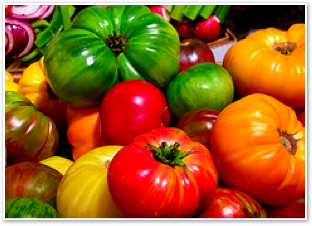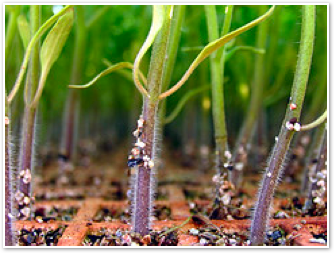


Growth:
In the wild, tomatoes grow up to 8 feet and even larger. As many tomatoes today are grown for commercial use in a greenhouse setting, the plant grows to the average height of 3 feet tall, with many being smaller. The vines are covered with tiny, short,hairs, which help the plant recognize when the vine needs to become roots (when moisture and soil are abundant). The roots go deep into the soil allowing for good adsorption of nutrients.1
As a tomato plant grows the stem is continuously branched. The plant grows from the tip, where a bud resides. After the plant has grown for some time, the tip begins to flower, in which the lateral buds begin to grow into more vines. 1
The leaves are compound, so there are many many leaflets, or distinct areas, which join to a specific stem. 4
The flowers come off of the apical meristem and have a tendency to be self-fertilizing. In order to survive in the Americas, where the tomato originated, the plant adapted to self-fertilization due to the absence of honeybees and other pollinators.1,4
Tomatoes are commonly seen as red, but are also found to be yellow, orange, pink, or white. In the wild, the tomatoes are found to be small, and only the red ones are edible. Also, tomatoes are known to be circular, but actually are found to be flat, plum- or pear-shaped. 1
Due to the high growth of tomato stems when grown in optimal conditions, wire cages are often used to hold the weak stalks up. Since tomatoes can grow to be quite large (with 7 pounds, 12 ounces being the world record holder), the stems have a difficult time bearing the multiple fruits per stem. 1,12



Tomatoes grow best at 21-24 degrees Celsius and can not survive cold temperatures which would produce frost. They require a high light intensity (around 6 hours), so they need to have access to the sun or a man-made light source. As for the soil, tomatoes are fairly tolerant of many conditions. With the exception to excessive cold soil, tomatoes can grow with fertile and well drained soils. Optimal pH would be around 5.5-7, which is slightly acidic.1,2
Uses:
As many can guess, tomatoes are mainly grown for their commercial use as edible fruits. Cultivated tomatoes have a large array of different types, each of which is used for a specific food, flavor, and texture (Fig. 1.). As a leading garden fruit in the United States, the tomato has a tendency of out-producing the needs of the cultivator. 3,8
Figure 1.
Size Uses
Beefsteak Tomato large sandwiches
and similar
applications
Plum Tomato medium tomato
sauce and
paste
Cherry Tomato small salads,
eaten
whole





Reproduction:
As the most advanced terrestrial plants, angiosperms have an alternation-of-generation life-cycle. Reproduction begins with the formation of the flower on the mature sporophyte plant. Within the anther of the flower, microsporocytes go through meiosis to become haploid micro-spores. These micro-spores then go through meiosis to produce the gametophyte, which is multicellular and haploid. The gametophyte continues to undergo mitosis to form gametes which get fertilized for form a diploid zygote. The embryo then forms within the embryo sac, which makes the fruit covering of the seeds. Once the seed is shed from the plant, the fruit acts as a protective covering until the right environmental conditions are met, where germination occurs and embryo can grow into a mature diploid sporophyte plant. This plant then produces flowers. 4,11


Site designed by Chloe Scheel, Last updated April 2009.

Although many suspect the tomato to be a vegetable, it is classified as a fruit. The actual portions of the plant which is known as the tomato is called the berry. After fertilization, the ovary develops
the fruit as a way of protecting the seeds. With a fruit covered seed, the plant has a better chance to germinate and reproduce. 4
Habitat:
As the fruit of the vein, tomatoes can be indeterminate or determinate. The indeterminate variations are short-lived perennials in temperate climates and produce bush tomatoes.
While the determinate variations are annual in all climates. As indeterminate plants, they can grow up to 8 feet tall, whereas the determinate species stop growing earlier. Enough space for the plant to grow to the maximum height, which allows for greater surface area, is needed for increased survival. 1,3












Figure 2. Alternation of Generations

Tomatoes can grow extremely well when the correct conditions are met, but when the unexpected pests interfere with the maturity of the plant, thats when tomato cultivators run into trouble. Check out some of these pests here!